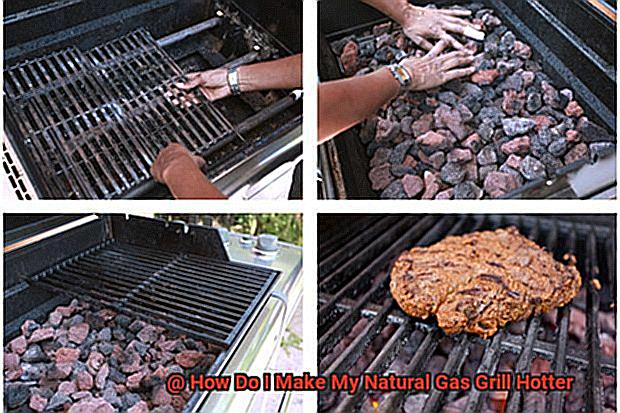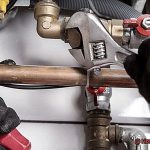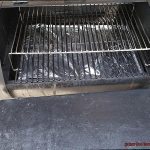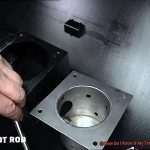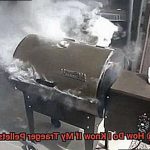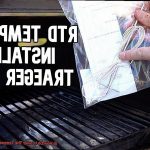Imagine biting into a juicy burger with perfectly caramelized vegetables and a charred steak that’s cooked to perfection. That smoky, grilled flavor is hard to beat, but what if you can’t cook outdoors? Don’t worry. With a few tips and tricks, you can bring that delicious outdoor grill taste indoors.
One of the main differences between indoor and outdoor cooking is the lack of smoke. Smoke plays a crucial role in adding flavor to your food. To recreate that smoky taste indoors, there are a few options. You can use a smoking box or wood chips by placing them in the oven or on the stovetop to let the smoke work its magic. Alternatively, try using smoked seasonings or marinades for an extra burst of flavor.
Another challenge when cooking indoors is achieving that perfect sear. To do this, preheat your skillet or grill pan until it’s hot enough to sear your meat, then let it cook without moving it around too much. This creates a crispy crust that locks in the juices and gives your food that grilled taste.
In this blog post, we’ll dive deeper into more tips and tricks for getting that outdoor grill taste inside your home. Get ready to impress your dinner guests with mouthwatering results.
Contents
Choosing the Right Type of Indoor Grill
With indoor grilling, you don’t have to. But with so many types of indoor grills available, it’s important to choose the right one to achieve that authentic outdoor grill taste. Let’s explore the different types of indoor grills and their unique advantages and disadvantages.
Electric Grills
Electric grills are here to save the day. As an expert on electric grills, I can assure you that they offer numerous advantages for indoor grilling.
One of the most significant benefits of electric grills is that they are smokeless. You can now grill inside without worrying about your smoke alarms going off or filling your home with smoke. No more standing outside in unfavorable weather conditions just to get your grill fix.
Electric grills also offer that familiar char-grilled flavor that everyone loves. Although they may not get as hot as traditional outdoor grills, they can still give you that mouth-watering taste you’re craving. Plus, you won’t have to deal with messy charcoal or propane tanks anymore.
Cleaning up after using an electric grill is a breeze. Most models have removable plates that can be effortlessly washed in the sink or dishwasher, eliminating the need for scrubbing down a dirty grill and making cleanup quick and easy.
When shopping for an electric grill, look for one with adjustable temperature control. This feature enables you to cook a variety of foods at different temperatures, giving you flexibility and versatility in your cooking. Also, consider the size of the grill and whether it will fit in your kitchen or on your countertop.
Stovetop Grills
Worry no more- stovetop grills are here to save the day. As an expert in this field, I can assure you that stovetop grills offer a plethora of benefits for indoor grilling enthusiasts.
Firstly, stovetop grills are incredibly versatile and can be used on any stovetop- gas, electric, or induction. They are also portable and easy to store, making them a perfect option for those living in apartments or homes with limited outdoor space. Plus, with their smokeless cooking experience, you won’t have to worry about setting off your smoke alarms.
To achieve the best results with a stovetop grill, it’s essential to preheat the grill for several minutes before adding your food. This ensures that your food cooks evenly and develops that mouth-watering char-grilled flavor we all love. Additionally, using non-stick spray or oil will prevent your food from sticking to the grill, making clean-up a breeze.
One of the biggest advantages of using a stovetop grill is the control you have over the temperature compared to an outdoor grill. If you find that your food is cooking too quickly, simply adjust the temperature on your stove. You can also experiment with different cooking techniques such as searing or smoking to achieve unique flavors and textures.
When it comes to choosing a stovetop grill, there are several options available. Cast iron grills provide excellent heat retention and durability, while aluminum grills are lightweight and easy to clean. Non-stick grills are also popular due to their convenient clean-up process.
Grill Pans
Look no further than a trusty grill pan. As an expert in all things grilling, I’m here to share my tips and tricks on how to use a grill pan indoors to achieve the best results.
First things first, preheat your grill pan before adding any food. This is crucial to ensure that the pan is hot enough to sear your food and create those desirable grill marks. Use a high smoke point oil, such as canola or avocado oil, to avoid excessive smoke in your kitchen. Once your pan is hot and ready to go, get ready to cook up a storm.
One of the biggest benefits of using a grill pan is the versatility it offers. You can cook many types of food that would typically be grilled outdoors, such as steak, chicken, vegetables, and even fruit. The possibilities are endless. To achieve the best results, use a thin cut of meat and avoid overcrowding the pan. This will allow your food to cook evenly and create those delicious grill marks we all love.
Not only does a grill pan add flavor and texture to your meals, but it’s also incredibly easy to clean. Most are made of cast iron or non-stick materials, making them a breeze to wipe down with a damp cloth or sponge. Some can even be placed in the dishwasher for even easier cleaning. No more scrubbing grime off an outdoor grill – with a grill pan, you can have your cake and eat it too.
Selecting the Right Fuel for Indoor Grilling
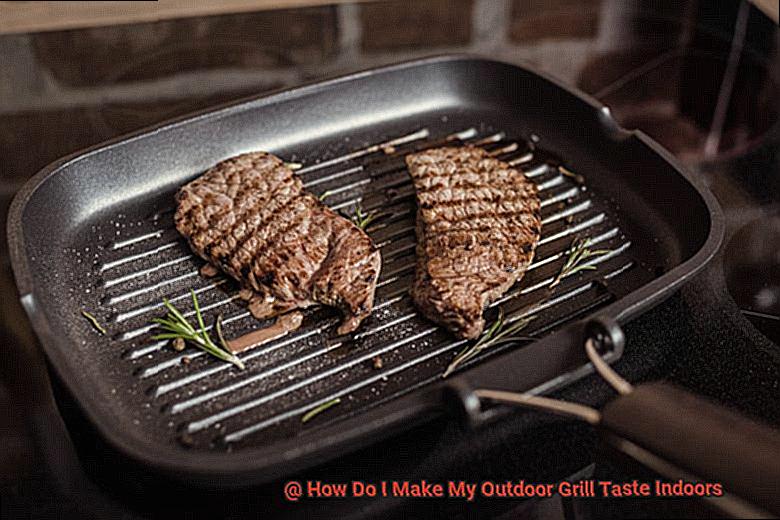
Thankfully, indoor grilling is a fantastic solution. However, selecting the right fuel can make or break your meal. As an expert in this field, I’m excited to share with you the various fuel options for indoor grilling and their advantages and disadvantages.
First on our list are propane or natural gas grills. These are excellent options for indoor grilling as they offer quick heating and precise temperature control. Additionally, they’re safe to use indoors as they don’t produce smoke or soot. However, if you’re looking for that authentic smoky flavor, propane or natural gas grills may not be the best option.
If you’re looking to infuse your food with smoky flavors, then wood pellets or chips with an indoor smoker is the way to go. These come in various flavors such as hickory, mesquite, applewood, and cherry to cater to a variety of palates. The choice of wood depends on personal preference and the type of food being cooked.
Charcoal grills are another popular option for outdoor grilling. They offer that authentic smoky flavor that we all crave. But, they do produce a lot of smoke and soot which can be problematic for indoor use. However, there are indoor charcoal grills designed specifically for indoor use with ventilation systems that eliminate smoke and soot.
Lastly, electric grills are convenient and practical options for indoor grilling. They’re easy to use and don’t produce any smoke or soot. However, they may not provide the same smoky flavor as other methods.
In conclusion, selecting the right fuel for indoor grilling depends on personal preference and desired flavor profiles. Propane or natural gas grills are great for precise and quick cooking without producing smoke or soot. Wood pellets or chips with an indoor smoker provide that much-needed smoky flavor. Charcoal grills offer the same flavor but require ventilation to eliminate smoke and soot. Electric grills are convenient but may not provide the same smoky flavor as other methods.
Liquid Smoke
Look no further than Liquid Smoke. This popular additive captures the essence of burning wood chips and condenses it into a liquid form, making it easy to add that signature smokiness to your dishes.
Using Liquid Smoke is a breeze – simply brush or spray it onto your food before cooking, or mix it in with your marinade or sauce. However, it’s important to remember that a little goes a long way. Add too much and you risk overpowering the taste of your meal.
When using Liquid Smoke indoors, proper ventilation is crucial. Without it, you could end up with an overwhelming amount of smoke lingering in your home. Be sure to use a hood or fan to remove the smoke and keep your kitchen smelling fresh.
Liquid Smoke can be used on a variety of foods, from meats and fish to vegetables and cheese. It’s a versatile ingredient that can make any dish taste like it was cooked outdoors. Plus, it’s a great option for those who don’t have access to a smoker or grill.
Marinades and Dry Rubs
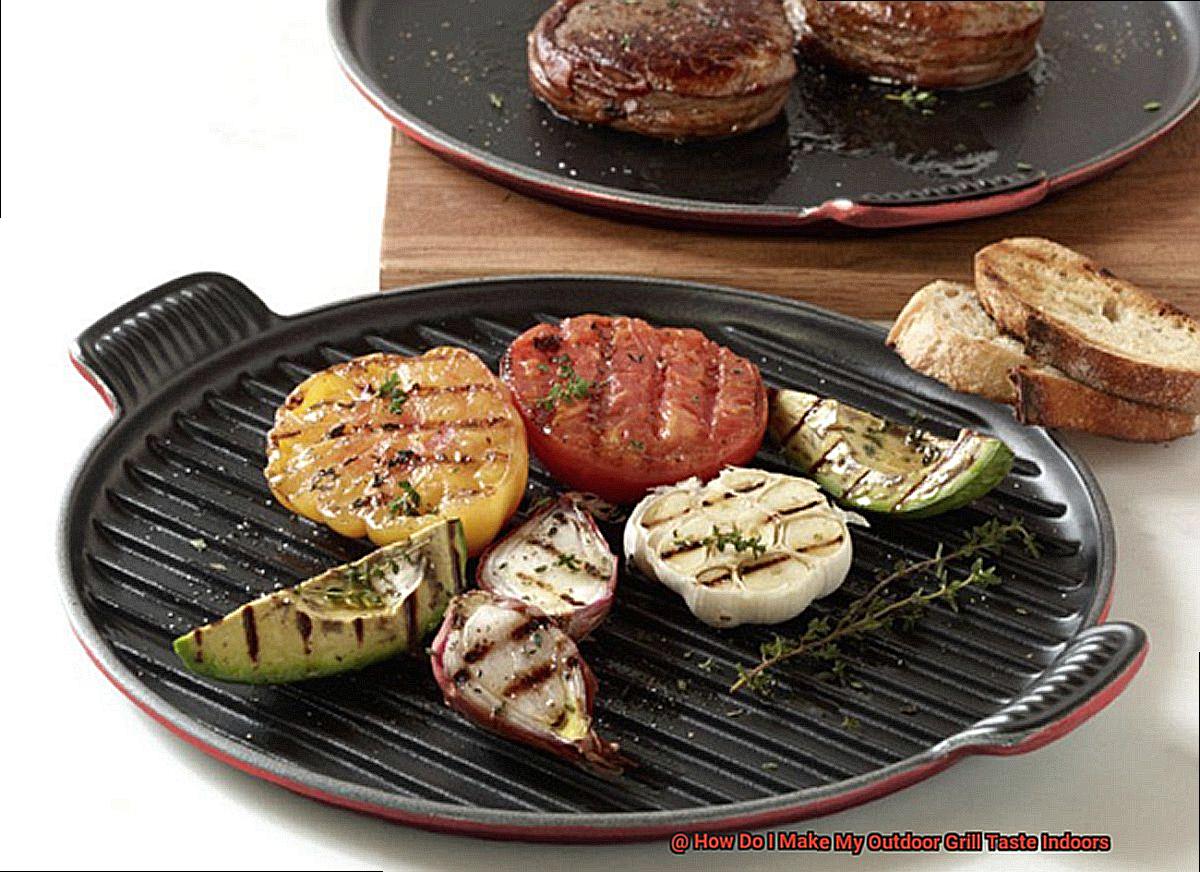
Look no further than marinades and dry rubs to elevate your meal. These two techniques are simple yet effective ways to add flavor and depth to your dishes.
First, let’s dive into marinades. This technique involves soaking meat or vegetables in a flavorful mixture of oil, acid, and spices for several hours before cooking. Not only do marinades add intense flavor, but the acid helps break down connective tissues resulting in a more tender and juicy dish. There is no limit to the possibilities with marinades – keep it simple with olive oil, garlic, and lemon juice or get creative with herbs like rosemary or thyme.
On the other hand, dry rubs are a mixture of spices and herbs that are rubbed onto the surface of the meat before cooking. They are versatile and customizable to your personal taste preferences. A classic dry rub includes salt, pepper, paprika, garlic powder, and onion powder. However, feel free to add other spices like cumin, chili powder, or brown sugar for a unique twist. Make sure to massage the dry rub into the meat thoroughly for maximum flavor.
So which one should you choose? It ultimately depends on your desired outcome. If you want a more tender and juicy dish with intense flavor, go for a marinade. But if you’re looking for a quick and easy solution that still packs a punch, then a dry rub is your answer.
When indoor grilling with either technique, invest in a grill pan or cast-iron skillet to achieve that outdoor grilled taste. You can also add wood chips or charcoal to your indoor grill pan for an added smoky flavor.
Preheating Your Indoor Grill
Preheating your indoor grill is the solution you’ve been looking for.
When it comes to indoor grilling, preheating is essential. Here’s why:
- Even Cooking: Preheating your grill ensures that it reaches its maximum temperature, which means your food will cook evenly. Without preheating, you risk undercooking or overcooking certain parts of your dish.
- Beautiful Grill Marks: Those coveted grill marks aren’t just for show – they add flavor and texture to your food. Preheating allows your grill to create those marks perfectly.
- Moisture Evaporation: During the preheating process, any excess moisture on the cooking surface evaporates. This prevents your food from sticking and makes for a more enjoyable cooking experience.
So, how do you properly preheat your indoor grill? Start by turning it on and setting it to the desired temperature. Let it heat up for at least 10-15 minutes with the lid closed. Avoid opening the lid during this process, as it can cause the temperature inside the grill to drop and result in uneven cooking.
Once your indoor grill has reached the desired temperature, it’s time to start grilling. Place your food on the preheated grill and cook according to your recipe’s instructions. Remember to adjust the heat as needed throughout the cooking process to prevent burning and ensure even cooking.
Using High Heat to Mimic Outdoor Grilling
As a true grill master, you know that one of the most crucial elements of outdoor grilling is the high heat used to cook the food. But what do you do when you can’t take your cooking outside? Fear not, fellow grill lovers. There are several methods to achieve high heat and mimic outdoor grilling indoors.
One great option is to use a cast-iron skillet or griddle on your stove. These materials distribute heat evenly and retain it well, resulting in a sear on meats and vegetables that is similar to what you would get on an outdoor grill. Don’t forget to preheat your skillet or griddle for at least 5-10 minutes before cooking, so it reaches the necessary high temperature.
Another method for high-heat indoor grilling is using a broiler. Acting as an upside-down grill, the broiler emits high heat from above, giving your food a quick and even cook. To use a broiler, preheat it for a few minutes before placing your food on a broiler pan and sliding it underneath. Be sure to keep a close eye on your food as it cooks, as it can go from perfectly cooked to burnt in a matter of seconds.
Last but not least, using a grill pan on your stove is another way to mimic outdoor grilling with high heat indoors. The ridges on the pan mimic the grates of an outdoor grill, allowing you to achieve those coveted grill marks on your food. Preheat the grill pan for at least 5-10 minutes before cooking to ensure that it reaches the necessary high temperature.
Seasoning and Temperature Control for Optimal Flavor
Don’t worry, with the right seasoning and temperature control techniques, you can achieve optimal flavor when grilling indoors. As an expert in this field, let me share with you some tips to make your indoor grill taste like it was cooked outside.
Seasoning is the foundation for creating a mouth-watering grilled dish. Don’t be afraid to experiment with different seasonings to find the perfect match for your meat. A simple blend of salt, pepper, and garlic powder works wonders for steak, while chicken comes alive with a combination of salt, pepper, paprika, and thyme. Apply your seasoning generously to add depth and flavor to your dish.
Temperature control is equally important. To achieve that perfect outdoor taste, preheat your grill for at least 5-10 minutes before cooking, ensuring it reaches the necessary high temperature. This will help you achieve those beautiful grill marks and a caramelized crust on your food. Throughout the cooking process, monitor the temperature of your grill using a thermometer or adjusting the heat source as needed.
When cooking thick cuts of meat, start at a high temperature to sear the outside and then reduce the heat to cook the inside without burning the outside. Remember that timing is essential to prevent overcooking or undercooking.
In summary, here are some key takeaways for achieving that optimal flavor when grilling indoors:
- Choose the right seasoning for your meat.
- Preheat your grill for at least 5-10 minutes before cooking.
- Monitor the temperature of your grill throughout the cooking process.
- Adjust heat source or use thermometer when necessary.
- Start at a high temperature for thick cuts of meat and reduce heat as needed.
Tips for Cleaning and Maintaining Your Indoor Grill
Indoor grilling has become an increasingly popular way to enjoy the taste of grilled foods without having to venture outside. However, just like outdoor grilling, proper cleaning and maintenance are essential for keeping your indoor grill in top condition and producing delicious results.
Clean after each use
The first and most important tip is to clean your indoor grill after every use. This will prevent the buildup of any residue or bacteria that could affect the flavor of your food. To clean your indoor grill, let it cool down completely, then use a brush or scraper to remove any food debris or grease from the grates. Finally, wipe down the grates and other surfaces with warm, soapy water and a soft-bristled brush or sponge.
Check for wear and tear
Regularly inspect your indoor grill for signs of wear and tear such as cracked or broken grates, loose parts, or damaged surfaces. If you notice any issues, replace the affected parts as soon as possible to keep your grill functioning properly.
Use proper cleaning tools
When cleaning your indoor grill, avoid using abrasive materials like steel wool or harsh chemicals that could cause damage. Instead, opt for non-abrasive cleaners and a soft-bristled brush or sponge to keep your surfaces and grates in top condition.
Season the grates
Just like with outdoor grills, seasoning your indoor grill’s grates is essential for preventing sticking and improving flavor. To season your grates, heat them up until they’re hot, then rub them down with oil using a paper towel or cloth.
Store properly
Finally, when not in use, store your indoor grill in a cool, dry place to prevent rust or other damage. A protective cover can also help keep it in top condition.
Safety Considerations When Indoor Grilling
Indoor grilling is a fantastic option for those who want to avoid the elements while savoring the taste of outdoor grilling. However, it’s essential to keep safety considerations in mind to ensure a safe and enjoyable grilling experience.
First and foremost, proper ventilation is critical when indoor grilling. Smoke and fumes can accumulate quickly and become harmful if not correctly vented. It’s important to use the exhaust fan or open windows to allow fresh air to circulate in the room. Never grill indoors in an enclosed space without proper ventilation, such as a garage or basement.
Using the right equipment is another crucial safety consideration. Indoor grills are specifically designed for indoor use and come with features such as drip trays and non-stick surfaces that minimize smoke and reduce the risk of fire. Under no circumstances should you use an outdoor grill indoors as it can produce excessive smoke and pose a fire hazard.
Keeping flammable materials away from your indoor grill is equally important. This includes kitchen towels, curtains, and other combustible items. Always place your indoor grill on a sturdy and heat-resistant surface, such as a countertop or table, and never leave it unattended while in use.
Lastly, maintaining your indoor grill is essential for safe grilling. Regular cleaning after each use and inspecting it for any signs of damage or wear will keep your grill in top shape. Replace any worn parts immediately and always follow the manufacturer’s instructions for safe use.
Conclusion
If you’re looking to bring that delicious outdoor grill taste inside, there are a few key tips to keep in mind.
First and foremost, invest in a high-quality indoor grill or griddle that can replicate the searing heat of an outdoor grill. Additionally, don’t be afraid to experiment with different marinades, rubs, and seasonings to add depth and complexity to your dishes.
Finally, make sure you’re using the right cooking techniques – whether it’s searing a steak or smoking some ribs – to ensure that your indoor grilled meals are just as flavorful as anything you’d cook outside.

